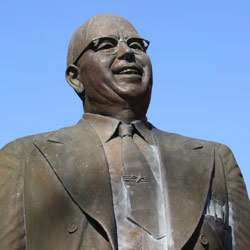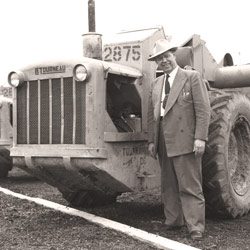
This mover of men and mountains was a prolific inventor and engineering genius in the tradition of Robert Fulton, Thomas Edison and Henry Ford.
All of us remember our first jobs and the thrill of earning our own money. I bet you also hold in your fond memory your first “real job.” Mine was in 1950 when I went to work for the R.G. LeTourneau Company right here in Peoria, Illinois.
I was right out of Woodruff High School, and I was a proud young man that first day at work, I can tell you that. When I came home after the Korean War, I went to LeToureau to get my job back. My old boss offered it to me, but suggested that I go to Bradley University under the G.I. Bill. “Norm, come on back when you have your degree,” he said, “and take over for me.” That was the attitude of the people at LeTourneau, and it all came from the man himself, Robert Gilmour LeTourneau.
I was fortunate to see Mr. LeTourneau several times as I rode around delivering office supplies. We had a “chapel hour” that was offered for the workers. Actually, it was only 30 minutes long, and if a worker did not want to attend that was his business. But most of us went because it gave us a chance to see the big boss, who often introduced the speaker for the day.
R.G. was a kind man, a man who many said had a slide ruler in one hand and a Bible in the other. I feel compelled to include this quote that showed Mr. LeTourneau’s humor. A reporter asked him how many men he had working for him. “Oh, I’d say about half of them,” he replied. Of course, the figures varied, but at one time or another he had over 6,000 on his payroll.
R.G., as he was respectfully referred to, was a common man, a self-educated man that rose to the top of the earthmoving business. His business—and his life—was guided by one principle, which he was happy to tell every writer that ever did a story on him. “God runs my business,” he would say, a big smile breaking out on his friendly face.
Throughout his life he was referred to as “God’s Businessman.” In a blink of his friendly eye, he would quote the book of Matthew, verse 33: “But seek ye first the Kingdom Of God, and his righteousness, and all these things will be added unto you.” That’s who R.G. really was, and you can read that verse on his statue, located by the tennis courts in Glen Oak Park. That very statue has a twin located on the campus of LeTourneau University in Longview, Texas.
I have heard Peorians speak of Mr. LeTourneau as if Peoria, Illinois, had “first dibs” on him, a phrase we used as kids. The truth was that he was a man of the world, and Peoria was just one piece of his incredible life. Born in Vermont, Virginia, on November 30, 1888, he would accumulate over 300 patents before he succumbed to the effects of a stroke on June 1, 1969, in Longview, Texas.
R.G. was not much for formal schooling and always referred to himself as a self-educated man. He up and left his quiet, Christian home in Vermont at the tender age of 14 and began his career as an apprentice ironworker in Portland, Oregon, and then San Francisco, California. He became an expert welder, woodcutter and carpenter. By 1909, he was an experienced manual tradesman and was ready to take on the industrial world.
By 1911, he was a partner in an auto repair shop, and soon became an expert mechanic, with a total understanding of the combustion engine. He married Evelyn Peterson in 1917, and together they reared three boys and a girl. That same year, he was not allowed to become a soldier because of neck injuries he sustained while racing motorcars. Instead, he went to work in a naval shipyard where he honed his skills as a welder and electrician. In 1920 he bought a used Holt tractor and began a grading business. In late 1921, he had his own machine shop where he designed and built different types of scrapers and electrical engines. Soon after that, he formed the R.G. LeTourneau Company that would bring him fame and riches beyond even his imaginative dreams.
His company was involved in massive projects like the Hoover Dam, and numerous road-building contracts that kept him busy until 1933. Unable to devote enough of his time to his inventing and dreams of manufacturing his own machines, he sold the business. It was 1935, when R.G. came to Peoria with the idea of building his factory and getting on with his dream. From that day forward, the rest is history, as folks like to say, and most of his dreams came true right here.
 By 1935, Peoria, Illinois had made a tremendous leap from the throes of the Great Depression and the agonies of Prohibition. Our population within the city limits was set at 104,969 and growing, along with Peoria County. Folks here in Peoria were optimistic, and for the first time in a long time, they had a bit of jingle in their pockets, and life was good. R.G. came to Peoria to be close to Caterpillar, the maker of the engines that powered his road graders. It was that simple; he did not pick Peoria for any other reason. But the folks here benefited from his decision, not only then, but to this day through Komatsu, which is still in business on LeTourneau’s initial property.
By 1935, Peoria, Illinois had made a tremendous leap from the throes of the Great Depression and the agonies of Prohibition. Our population within the city limits was set at 104,969 and growing, along with Peoria County. Folks here in Peoria were optimistic, and for the first time in a long time, they had a bit of jingle in their pockets, and life was good. R.G. came to Peoria to be close to Caterpillar, the maker of the engines that powered his road graders. It was that simple; he did not pick Peoria for any other reason. But the folks here benefited from his decision, not only then, but to this day through Komatsu, which is still in business on LeTourneau’s initial property.
So for R.G. and the world, it all started here in a small brick building on the north side of Peoria. His inventive mind and hard-working ethics would take him all over the world, amassing a fortune as he went. In 1953, he sold the Peoria business to Westinghouse Air Brake Company (WABCO) for a cool $25 million. Biographers of R.G. LeTourneau pretty much agree that he donated 90 percent of his fortune to charities and Christian organizations.
Retired employees who formed the LeTourneau Memorial Association were determined to honor their old boss with a fitting memorial. Four years later and armed with $25,000 in donations, their dream was realized. The 12-foot bronze memorial, designed by Keith Knoblock, is located in the upper section of Glen Oak Park. An additional $5,000 was raised to maintain the monument and presented to the Peoria Park District for perpetual care. On a sunny day in May of 1988, a century after his birth, nearly 1,000 people met to dedicate the statue of R.G. LeTourneau. Friends, dignitaries and members of the LeTourneau family attended. Evelyn, R.G.’s wife, had planned to attend the ceremonies, but she passed away in 1987 at the age of 86.
Although R.G. was not born here, people that knew him and admired his work boasted of his connection with Peoria, Illinois. His monument tells the world that we are proud of this gentle, philanthropically-oriented man, this industrial pioneer…this Peorian. iBi
Norm Kelly is a local historian and the author of eight books. He can be reached at norman.kelly@sbcglobal.net.

